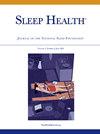Diversity, equity, and inclusion: Findings from the Sleep Research Society
IF 3.4
2区 医学
Q2 CLINICAL NEUROLOGY
引用次数: 0
Abstract
Objectives
To characterize representation and inclusion among Sleep Research Society members and examine associations between sociodemographic features and Sleep Research Society experiences.
Methods
The Sleep Research Society Taskforce for Diversity and Inclusion developed a web-based questionnaire in 2021, assessing membership data and Sleep Research Society experiences (self-initiated and society-initiated participation, feeling very welcomed, perceptions of inclusiveness, and diversity of viewpoints represented). Frequencies were calculated and adjusted Poisson regression models with robust variance were fit to estimate associations.
Results
Most participants (n = 388; 35.7% of members) were aged 18-49 (61%), non-Hispanic White (65%), and women (59%). Regarding inclusion, 41% participated in ≥2 Sleep Research Society self-initiated activities (abstract submission), 56% in Sleep Research Society-initiated activities (appointed position), 51% felt welcomed, whereas 52% perceived a lack of inclusivity and 65% a lack of diverse viewpoints. Historically minoritized groups and women felt less welcomed compared to non-Hispanic White members and men. Older, biracial, women, gender-divergent, and U.S.-born individuals, were less likely to perceive that there was a diversity of viewpoints represented in the Sleep Research Society. Members of ≥10 years and those with a doctoral degree were more likely to participate in Sleep Research Society activities, while sexual and gender minoritized individuals were less likely to do so. Sexual and gender minoritized individuals were more likely to report Sleep Research Society was noninclusive.
Conclusions
Historically minoritized individuals are under-represented in Sleep Research Society and a majority of respondents report not feeling welcomed. These results serve as a baseline benchmark and example for assessing the impact of ongoing and future diversity and inclusion initiatives and provide targets for expanding opportunities for underrepresented individuals in sleep/circadian societies.
多样性、公平性和包容性:睡眠研究学会的研究结果。
目的描述睡眠研究学会会员的代表性和包容性,研究社会人口特征与睡眠研究学会经历之间的关联:睡眠研究学会多样性和包容性工作组于 2021 年开发了一份基于网络的调查问卷,评估会员数据和睡眠研究学会经历(自我发起和社会发起的参与、非常受欢迎的感觉、对包容性的看法以及所代表观点的多样性)。我们计算了频率,并拟合了具有稳健方差的调整泊松回归模型,以估计相关性:大多数参与者(n = 388;占会员总数的 35.7%)年龄在 18-49 岁之间(61%),非西班牙裔白人(65%),女性(59%)。在包容性方面,41%的人参加了≥2次睡眠研究协会自发组织的活动(提交摘要),56%的人参加了睡眠研究协会自发组织的活动(任命职位),51%的人感觉受到欢迎,而52%的人认为缺乏包容性,65%的人认为缺乏多元化观点。与非西班牙裔白人会员和男性相比,历史上的少数群体和女性感到不太受欢迎。年长者、双种族、女性、性别差异者和美国出生者较少认为睡眠研究学会代表了多元化的观点。≥10岁的会员和拥有博士学位的会员更有可能参加睡眠研究学会的活动,而在性别和性别上属于少数群体的人则较少参加。性和性别上属于少数群体的人更有可能表示睡眠研究协会不具有包容性:结论:历史上,少数群体在睡眠研究协会中的代表性不足,大多数受访者表示感觉不受欢迎。这些结果可作为基线基准和范例,用于评估当前和未来多样性和包容性倡议的影响,并为睡眠/昼夜节律协会中代表性不足的个人提供更多机会。
本文章由计算机程序翻译,如有差异,请以英文原文为准。
求助全文
约1分钟内获得全文
求助全文
来源期刊

Sleep Health
CLINICAL NEUROLOGY-
CiteScore
6.30
自引率
9.80%
发文量
114
审稿时长
54 days
期刊介绍:
Sleep Health Journal of the National Sleep Foundation is a multidisciplinary journal that explores sleep''s role in population health and elucidates the social science perspective on sleep and health. Aligned with the National Sleep Foundation''s global authoritative, evidence-based voice for sleep health, the journal serves as the foremost publication for manuscripts that advance the sleep health of all members of society.The scope of the journal extends across diverse sleep-related fields, including anthropology, education, health services research, human development, international health, law, mental health, nursing, nutrition, psychology, public health, public policy, fatigue management, transportation, social work, and sociology. The journal welcomes original research articles, review articles, brief reports, special articles, letters to the editor, editorials, and commentaries.
 求助内容:
求助内容: 应助结果提醒方式:
应助结果提醒方式:


